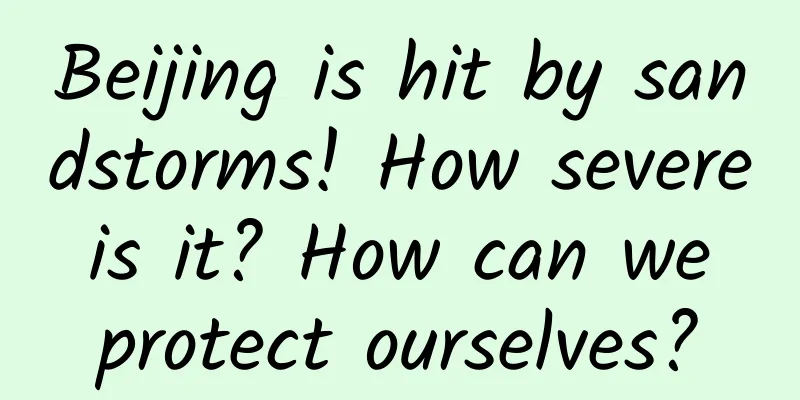Beijing is hit by sandstorms! How severe is it? How can we protect ourselves?

|
The Central Meteorological Observatory issued a yellow sandstorm warning at 6:00 on March 11: It is expected that from 8:00 on March 11 to 8:00 on March 12, there will be blowing sand or dust weather in southern Xinjiang, central and western Inner Mongolia, eastern Gansu, Ningxia, central and northern Shaanxi, Shanxi, Hebei, Beijing, Tianjin, northern Henan, northern Shandong, western Liaoning, and western Jilin. Among them, some areas in central and western Inner Mongolia will have sandstorms, and some areas will have strong sandstorms. Beijing Meteorological Observatory issued a report at 6:00 on the 11th: Today, it will be cloudy with occasional overcast during the day, with light showers in most areas and light fog. There will be sandstorms around dusk, with northerly to southerly winds of level 2 or 3, and the highest temperature will be 14°C; at night, it will be cloudy and clear with sandstorms, with southerly to northerly winds of around level 3, and the lowest temperature will be 6°C. Please bring rain gear when going out, and pay attention to health protection and traffic safety. At 14:00 on the 11th, the Beijing Meteorological Observatory issued a blue warning for sandstorms: Affected by the transport of sandstorms from upstream, sandstorms are expected in the city from around dusk on the 11th to the morning of the 12th, so please take precautions. This is also the first sandstorm warning in Beijing this year. At the same time, atmospheric diffusion conditions have continued to deteriorate in recent days, and the PM2.5 concentration in Beijing and surrounding areas has increased significantly. A regional pollution process has occurred, with some areas and periods of time reaching moderate to severe pollution. Under the influence of unfavorable diffusion meteorological conditions and regional pollution, the PM2.5 concentration in Beijing has gradually accumulated and increased since the 8th. From 20:00 on the evening of the 10th, the PM2.5 concentration rose to a moderate pollution level. At 8:00 on the morning of the 11th, the concentration was 147 micrograms/cubic meter, reaching a moderate pollution level. Some areas have reached severe pollution. The meteorological conditions during this process were extremely unfavorable and lasted for a long time. Under the control of the equal pressure field and the high-in-the-east-low-in-the-west situation field, the Beijing-Tianjin-Hebei region had southerly winds on the ground for many consecutive days, prompting long-distance and near-peripheral pollution to be continuously transmitted and converged northward. At the same time, the humidity rose to near saturation at night, and high humidity inversion occurred in the morning. The boundary layer dropped from more than 1,000 meters to about 400 meters. The atmospheric environmental capacity was greatly compressed, and the diffusion conditions further deteriorated. The regional pollution transmission and local pollution accumulation caused this pollution process. At the same time, the secondary transformation was strengthened under high humidity conditions, and the proportion of secondary inorganic aerosols in the PM2.5 components increased significantly, especially the nitrates formed by NOx emissions from mobile sources and industrial sources accounted for the largest proportion. The forecast shows that during the day today, diffusion conditions will continue to be unfavorable and air pollution will continue; on the evening of the 11th, diffusion conditions in Beijing, Tianjin and Hebei will improve, and PM2.5 pollution will improve. However, due to the strong sandstorm weather in Mongolia on March 10, it is expected to arrive in Beijing with northwest winds on the evening of the 11th, and the impact of sandstorms on air quality will be most obvious at night. This foreign sandstorm has a large range and a heavy degree. It takes a long time to pass through Beijing, and PM10 will reach a high concentration level. Is the sandstorm in Beijing this time serious? Meteorological experts explained that the "sand source" area from eastern Mongolia to northeastern Inner Mongolia is still covered with snow, so there is not much sand and dust that can be blown up. During the day on Wednesday, Beijing still had gusts of about level 6, and some local loose soil would be blown up. Around dusk, the sand and dust settled to the surface, and the impact of this sandstorm weather was basically over. At night, with the continued northwest wind, the city's air quality is expected to improve to a good level. Later this week, the cloud cover will increase again, with rain and snow in the western and northern parts on Saturday and stronger northerly winds on Sunday. Affected by the above two cold fronts, the temperature will gradually drop this week, with the highest temperature dropping to around 8℃ over the weekend. It is expected that from March 11 to March 18, the highest daytime temperature will be 8℃~16℃ and the lowest nighttime temperature will be -1℃~5℃. Spring (March to May) is the season when sandstorms occur most frequently in northern my country. What are the hazards? How should we protect ourselves against sandstorms? What are the health hazards of sandstorms? Dust weather refers to a weather phenomenon in which strong winds blow up large amounts of sand and dust from the ground, making the air turbid and reducing atmospheric visibility. ★ Eyes: The first to be hurt In windy and dusty weather, if sand enters your eyes and causes a foreign body sensation, do not rub them vigorously. Instead, rinse them with running water as soon as possible. If you still feel discomfort or the condition is serious, seek medical attention immediately. ★ Respiratory system: vulnerable to damage During sandstorm weather, the concentration of inhalable particulate matter in the air increases significantly. These particles can enter the human respiratory tract and alveoli, and various pathogens such as bacteria and viruses are adsorbed on their surface, increasing the risk of respiratory diseases such as bronchitis, pneumonia, and emphysema. ★ Skin: Cleansing and moisturizing are the most important The air is dry in windy and dusty weather, and the moisture on the surface of the skin is easily lost, so you should replenish water, moisturize and apply appropriate sun protection. Dust weather can also induce cardiovascular, respiratory, central nervous system and immune system diseases, affecting human health. Who are the sensitive groups to sandstorm weather? The elderly, children, pregnant women, and people with respiratory and cardiovascular diseases are sensitive groups. During dusty weather, people should try to avoid going out. If they have chronic cough with sputum or shortness of breath, paroxysmal wheezing and chest pain, they should seek medical attention as soon as possible. People who have to work outdoors due to their jobs, such as traffic police, sanitation workers, construction workers, etc., should take personal protective measures. What to do when encountering sandstorm weather? When sandstorms occur, residents should stay indoors as much as possible and take appropriate measures: ① Close doors and windows in time. If necessary, seal them with tape to prevent sand and dust from entering the room. ② Use wet dust removal methods such as mopping the floor with a wet mop and wiping with a wet rag to keep the room clean and avoid re-suspension of indoor dust. ③You can use humidifiers, sprinklers and other methods to maintain appropriate air humidity. ④If conditions permit, turn on the air purifier indoors. If you need to go out, pay attention to personal protection ① Wear a mask to reduce the damage to the respiratory tract caused by wind and sand. In sandstorm weather, there will be floating dust, inhalable particles and fine particles at the same time, so it is advisable to wear a particle protection mask. ② Wear windproof glasses to prevent wind and sand from damaging your eyes. If wind and sand enter your eyes, do not rub them with your hands. Rinse with running water or use eye drops as soon as possible. If you still feel uncomfortable, seek medical attention immediately. ③ Wear hats, scarves and other dust-proof equipment, and wrap your head with the scarf to prevent wind and sand from damaging your skin, hair, ears, etc. ④ Strengthen cleaning. Wash your hands and face immediately after going out, rinse your mouth with clean water, clean your nasal cavity, take a bath if conditions permit, and change clothes in time to keep your body clean and comfortable. In addition, during sandstorms, the air is dry, which can easily lead to chapped lips, dry and itchy nose and throat, etc. Drink more water and eat more fruits and vegetables rich in vitamins to keep the respiratory tract unobstructed and moist, and relieve the discomfort of the throat. Once symptoms such as eye discomfort, cough, shortness of breath, chest tightness or pain appear, you should seek medical attention as soon as possible and receive appropriate treatment under the professional guidance of a doctor. Kind tips During the transition from winter to spring, the weather changes from cloudy to sunny, and the temperature fluctuates greatly. Please pay attention to the latest weather information in time and take precautions. As spring approaches and everything revives, the pollen concentration will gradually increase. People who are sensitive to pollen need to pay attention to pollen forecasts in time and take care of their health. Source: China National Meteorological Administration, @天气北京, Beijing Center for Disease Control and Prevention |
>>: Does frequent earwax cleaning help ear canal health? Don’t do it!
Recommend
This may be the only lizard with an oxygen tank
Produced by: Science Popularization China Author:...
What is brand community identity?
In this era of material prosperity, the dazzling ...
Why do some people get drunk as soon as they drink? Is it because of their health or because they chose the wrong wine?
Mixed Knowledge Specially designed to cure confus...
How to write text message advertising content that touches the heart and the heart? 4 copywriting skills you must master
If you want to achieve unexpected results with SM...
The majestic dream-eating monster has become the great enemy of the national treasure
What animal can you think of that looks a bit lik...
Experience summary | Building a user incentive system for your own APP from scratch
Recently, the company’s new product has begun pla...
Why can't you get your tan back? It must be because you didn't do these things! The last trick is the most important!
In the hot summer, more and more fairies like to ...
Java Reflection Best Practices
The examples in this article can be seen and down...
UI operations in the main thread are not absolutely safe
[[185244]] When we first started learning iOS, we...
What are the body's reactions when bitten by a venomous snake?
There are more than 3,340 species of snakes in th...
Tell your parents! Huaxi doctors: Using these bags to store food can really cause food poisoning
The old-style pickled cabbage of 315 is still fre...
How far are we from AGI? The big model is not the final solution, the world model is the future
In science fiction movies, AI systems like JARVIS...
With today’s headlines advertising, how to plan creative advertising for the wedding industry?
The threshold for entering the current marriage a...
4 key data of the top 10 short video applications!
Do you know which short video app is used the lon...
A money-making project for making friends and fans, suitable for studios to scale up in batches
As we all know, the short video industry is very ...









